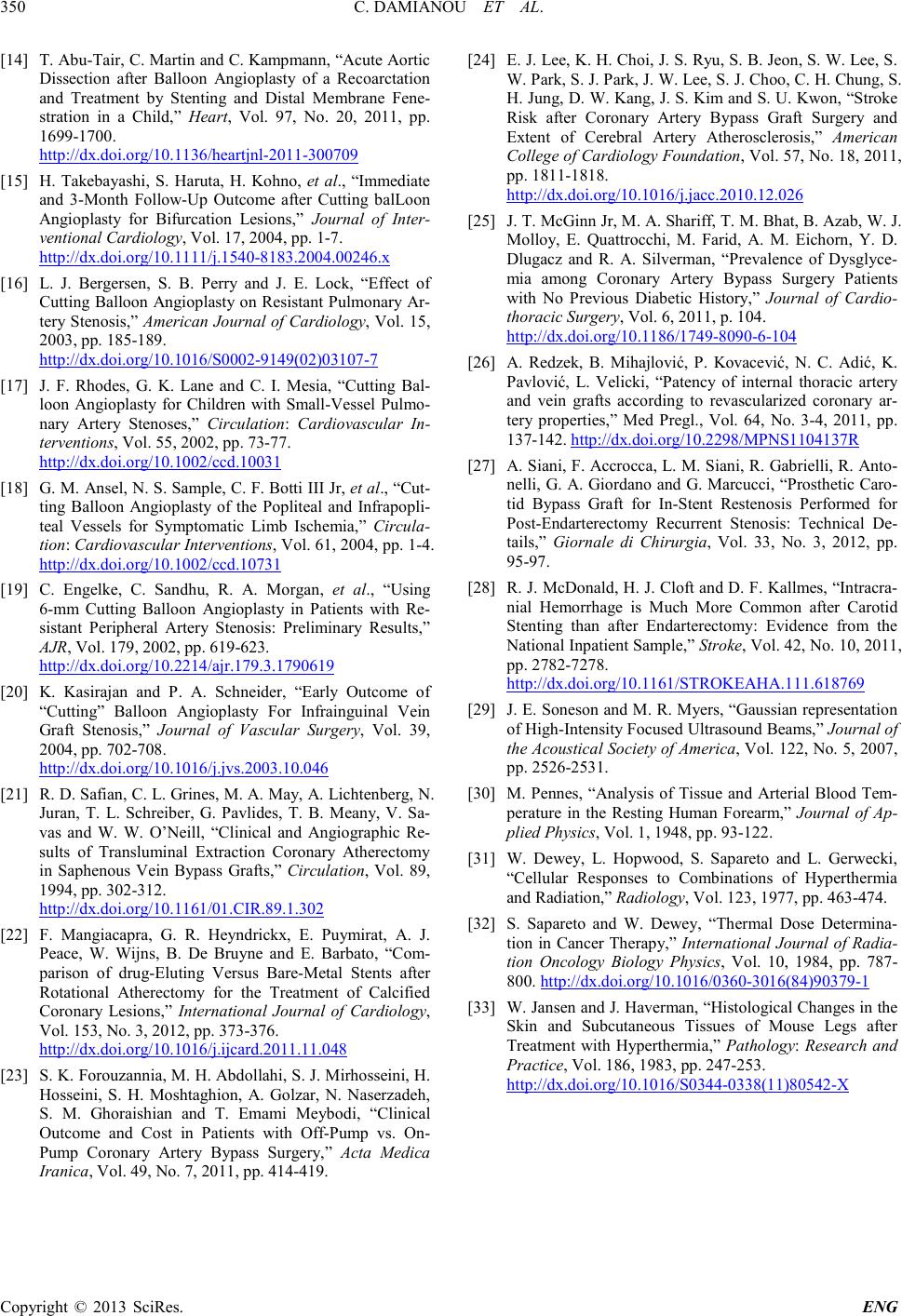
C. DAMIANOU ET AL.
Copyright © 2013 SciRes. ENG
[14] T. Abu-Tair, C. Martin and C. Kamp ma n n , “Acute Aortic
Dissection after Balloon Angioplasty of a Recoarctation
and Treatment by Stenting and Distal Membrane Fene-
stration in a Child ,” Heart, Vol. 97, No. 20, 2011, pp.
1699-1700.
http://dx.doi.org/10.1136/heartjnl-2011-300709
[15] H. Takebayashi, S. Haruta, H. Kohno, et al., “Immediate
and 3-Month Follow-Up Outcome after Cutting balLoon
Angioplasty for Bifurcation Lesions,” Journal of Inter-
ventional Cardiology, Vol. 17, 2004, pp. 1-7.
http://dx.doi.org/10.1111/j.1540-8183.2004.00246.x
[16] L. J. Bergers en, S. B. Perry and J. E. Lock, “Effect of
Cutting Balloon Angioplasty on Resistant Pulmonary Ar-
te ry S tenosis,” Ameri can Journal of Cardiology, Vol. 15,
2003, pp. 185-189.
http://dx.doi.org/10.1016/S0002-9149(02)03107-7
[17] J. F. Rhodes, G. K. Lane and C. I. Mesia, “Cutting Bal-
loon Angioplasty for Children with Small-Vessel Pulmo-
nary Artery Stenoses,” Circulation: Cardiovascular In-
terventions, Vol. 55, 2002, pp. 73-77.
http://dx.doi.org/10.1002/ccd.10031
[18] G. M. Ansel, N. S. Sample, C. F. Bo tti III Jr, et al ., “Cut-
ting Balloon Angioplasty of the Popliteal and Infrapopli-
teal Vessels for Symptomatic Limb Isc h e mi a ,” Circula-
tion: Cardiovascular Interventions, Vol. 61, 2004, pp. 1-4.
http://dx.doi.org/10.1002/ccd.10731
[19] C. Engelke, C. Sandhu, R. A. Morgan, et al., “Using
6-mm Cutting Balloon Angioplasty in Patients with Re-
sistant Peripheral Artery Stenosis: Preliminary Results,”
AJR, Vol. 179, 2002, pp. 619-623.
http://dx.doi.org/10.2214/ajr.179.3.1790619
[20] K. Kasirajan and P. A. Schneider, “Early Outcome of
“Cutting” Balloon Angioplasty For Infrainguinal Vein
Graft Stenosis,” Journal of Vascular Surgery, Vol. 39,
2004, pp. 702-708.
http://dx.doi.org/10.1016/j.jvs.2003.10.046
[21] R. D. Safian, C. L. Gri n e s, M. A. M ay, A. Licht enber g, N.
Juran, T. L. Schreiber, G. Pavlides, T. B. Meany, V. Sa-
vas and W. W. O’Neill, “Clinical and Angiographic Re-
sults of Transluminal Extraction Coronary Atherectomy
in Saphenous Vein Bypass Grafts,” Circulation, Vol. 89,
1994, pp . 302-312.
http://dx.doi.org/10.1161/01.CIR.89.1.302
[22] F. Mangiacapra, G. R. Heyndrickx, E. Puymirat, A. J.
Peace, W. Wijns, B. De Bruyne and E. Bar bato, “Com-
parison of drug-Eluting Versus Bare-Metal Stents after
Rotational Atherectomy for the Treatment of Calcified
Coronary Lesions,” International Journal of Cardiology,
Vol. 153, No. 3, 2012, pp. 373-376.
http://dx.doi.org/10.1016/j.ijcard.2011.11.048
[23] S. K. Forouzannia, M. H. Abdollahi, S. J. Mirhosseini, H.
Hosseini, S. H. Moshtaghion, A. Golzar, N. Naserzadeh,
S. M. Ghoraishian and T. Emami Meybodi, “Clinical
Outcome and Cost in Patients with Off-Pump vs. On-
Pump Coronary Artery Bypass Surgery,” Acta Medica
Iranica, Vol. 49, No. 7, 2011, pp. 414-419.
[24] E. J. Lee, K. H. Choi, J. S. Ryu, S. B. Jeon, S. W. Lee, S.
W. Park, S. J. Park, J. W. Lee, S. J. Choo, C. H. Chung, S.
H. Jung, D. W. Kang, J. S. Kim and S. U. Kwon, “Stroke
Risk after Coronary Artery Bypass Graft Surgery and
Extent of Cerebral Artery Atherosclerosis,” American
College of Cardiology Foundation, Vol. 57, No. 18, 2011,
pp. 1811-1818.
http://dx.doi.org/10.1016/j.jacc.2010.12.026
[25] J. T. McGinn Jr, M. A. Shariff, T. M. Bhat, B. Azab, W. J.
Molloy, E. Quat trocchi, M. Farid, A. M. Eichorn, Y. D.
Dlugacz and R. A. Silverman , “Prevalence of Dysglyce-
mia among Coronary Artery Bypass Surgery Patients
with No Previous Diabetic History,” Journal of Cardio-
thoraci c Surgery, Vol. 6, 2011, p. 104.
http://dx.doi.org/10.1186/1749-8090-6-104
[26] A. Redzek, B. Mihajlović, P. Kovacević, N. C. Adić, K.
Pavlović, L. Vel icki, “Patency of internal thoracic artery
and vein grafts according to revascularized coronary ar-
tery properties,” Med Pregl., Vol. 64, No. 3-4, 2011, pp.
137-142. http://dx.doi.org/10.2298/MPNS1104137R
[27] A. Siani, F. Accrocca, L. M. Siani, R. Gabrielli, R. Anto-
nelli, G. A. Giordano and G. Marcucci, “Prosthetic Caro-
tid Bypass Graft for In-Stent Restenosis Performed for
Post-Endarterectomy Recurrent Stenosis: Technical De-
tails,” Giornale di Chirurgia, Vol. 33, No. 3, 2012, pp.
95-97.
[28] R. J. McDonald, H. J. Cloft and D. F. Kallmes, “Intracra-
nial Hemorrhage is Much More Common after Carotid
Stenting than after Endart erectomy: Evidence from the
National Inpatient Sample,” Stroke, Vol. 42, No. 10, 2011,
pp. 2782-7278.
http://dx.doi.org/10.1161/STROKEAHA.111.618769
[29] J. E. Soneson and M. R. Myers, “Gaussian rep resentati on
of High-Intensity Focused Ultrasound Beams,” Journal of
the Acou stical So ciety of America, Vol. 122, No. 5, 2007,
pp. 2526 -2531.
[30] M. Pennes, “Analysis of Tissue and Arterial Blood Tem-
perature in the Resting Human Forearm,” Journal of Ap-
plied Physics, Vol. 1, 1948, pp. 93-122.
[31] W. Dewey, L. Hopwood, S. Sap ar eto and L. Gerwecki,
“Cellular Responses to Combinations of Hyperthermia
and Radiation,” Radiology, Vol. 123, 1977, pp. 463-474.
[32] S. Sapareto and W. Dewey, “Thermal Dose Determina-
tion in Cancer Therapy,” International Journal of Radia-
tion Oncology Biology Physics, Vol. 10, 1984, pp. 787-
800. http://dx.doi.org/10.1016/0360-3016(84)90379-1
[33] W. Jansen and J. Haverman, “Histological Changes in the
Skin and Subcutaneous Tissues of Mouse Legs after
Treatment with Hyperthermia,” Pathology: Research and
Practice, Vol. 186, 1983, pp. 247-253.
http://dx.doi.org/10.1016/S0344-0338(11)80542-X